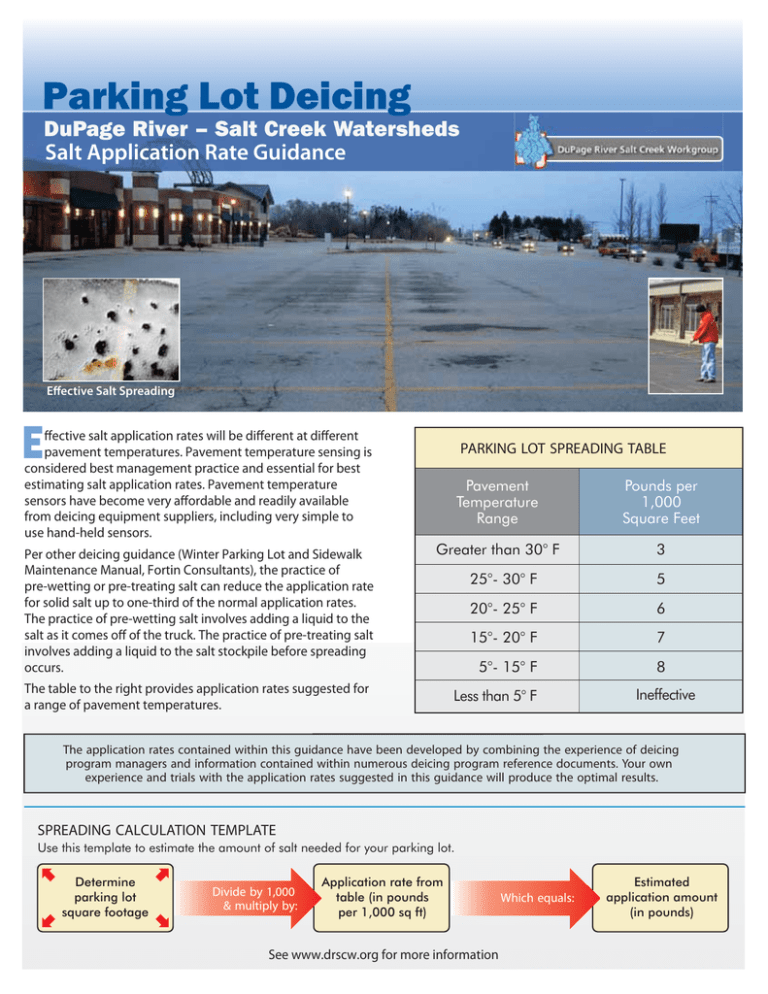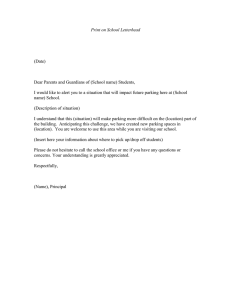Parking Lot Deicing - DuPage River Salt Creek Workgroup
advertisement

Parking Lot Deicing DuPage River – Salt Creek Watersheds Salt Application Rate Guidance Effective Salt Spreading ffective salt application rates will be different at different pavement temperatures. Pavement temperature sensing is considered best management practice and essential for best estimating salt application rates. Pavement temperature sensors have become very affordable and readily available from deicing equipment suppliers, including very simple to use hand-held sensors. PARKING LOT SPREADING TABLE Pavement Temperature Range Pounds per 1,000 Square Feet Per other deicing guidance (Winter Parking Lot and Sidewalk Maintenance Manual, Fortin Consultants), the practice of pre-wetting or pre-treating salt can reduce the application rate for solid salt up to one-third of the normal application rates. The practice of pre-wetting salt involves adding a liquid to the salt as it comes off of the truck. The practice of pre-treating salt involves adding a liquid to the salt stockpile before spreading occurs. Greater than 30° F 3 The table to the right provides application rates suggested for a range of pavement temperatures. Less than 5° F 25°- 30° F 5 20°- 25° F 6 15°- 20° F 7 5°- 15° F 8 Ineffective The application rates contained within this guidance have been developed by combining the experience of deicing program managers and information contained within numerous deicing program reference documents. Your own experience and trials with the application rates suggested in this guidance will produce the optimal results. SPREADING CALCULATION TEMPLATE Use this template to estimate the amount of salt needed for your parking lot. Determine parking lot square footage Divide by 1,000 & multiply by: Application rate from table (in pounds per 1,000 sq ft) See www.drscw.org for more information Which equals: Estimated application amount (in pounds) Parking Lot Deicing DuPage River – Salt Creek Watersheds Example 1: High School Parking Lot Sample Calculations Step 1: Check pavement temperature. Measure pavement temperature. For this example, assume the pavement temperature is 23°F. Step 2: Estimate parking lot size. Assume a medium sized parking lot measuring 200ft by 300ft (60,000 square feet). Step 3: Look up the application rate in the Parking Lot Spreading Table. For this parking lot example, the estimated application rate is 360 pounds, about seven 50lb. bags. (60,000 square feet) x (6 pounds/1,000 square feet) = 360 pounds Step 4: Spread salt evenly over the parking lot using your calibrated equipment. Example 2: Department Store Parking Lot Step 1: Check pavement temperature. Measure pavement temperature. For this example, assume the pavement temperature is 28°F. Step 2: Estimate parking lot size. Assume a large size parking lot measuring 300ft by 500ft (150,000 square feet). Step 3: Look up the application rate in the Parking Lot Spreading Table. For this parking lot example, the estimated application rate is 750 pounds, about fifteen 50lb. bags. (150,000 square feet) x (5 pounds/1,000 square feet) = 750 pounds Step 4: Spread salt evenly over the parking lot using your calibrated equipment. Funding for this guidance is provided in part by the Illinois Environmental Protection Agency through Section 319 of the Clean Water Act. See www.drscw.org for more information
